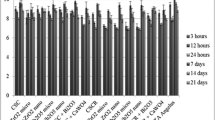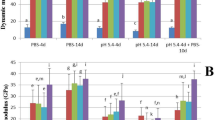Abstract
Objectives
All implants, bone and endodontic cements need to be sufficiently radiopaque to be able to be distinguished from neighbouring anatomical structures post-operatively. For this purpose, radiopacifying materials are added to the cements to render them sufficiently radiopaque. Bismuth oxide has been quite a popular choice of radiopacifier in endodontic materials. It has been shown to cause dental discoloration. The aim of this study was to develop, characterize and assess the properties of tricalcium silicate cement with alternative radiopacifiers, which are either inter-ground or sintered to the tricalcium silicate cement.
Methods
Custom-made endodontic cements based on tricalcium silicate and 20 % barium, calcium or strontium zirconate, which were either inter-ground or sintered at high temperatures, were produced. The set materials stored for 28 days in Hank’s balanced salt solution were characterized by scanning electron microscopy and X-ray diffraction analysis. Assessment of pH, leaching, interaction with physiological solution, radiopacity, setting time, compressive strength and material porosity were investigated. Mineral trioxide aggregate (MTA) Angelus was used as control.
Results
Addition of radiopacifying materials improved the radiopacity of the material. The sintered cements exhibited the formation of calcium zirconate together with the respective radiopacifier phase. All materials produced calcium hydroxide on hydration, which interacted with tissue fluids forming hydroxyapatite on the material surface. The physical properties of the tricalcium silicate-based cements were comparable to MTA Angelus.
Conclusions
A novel method of producing radiopaque tricalcium silicate-based cements was demonstrated. The novel materials exhibited properties, which were either comparable or else improved over the control.
Clinical relevance
The novel materials can be used to replace MTA for root-end filling, perforation repair and other clinical applications where MTA is indicated.











Similar content being viewed by others
References
Torabinejad M, White DJ Tooth Filling Material and Use (1995) US Patent Number 5,769,638.
Laghios CD, Benson BW, Gutmann JL, Cutler CW (2000) Comparative radiopacity of tetracalcium phosphate and other root-end filling materials. Int Endod J 33:311–315
Islam I, Chng HK, Yap AU (2006) Comparison of the physical and mechanical properties of MTA and Portland cement. J Endod 32:193–197
Camilleri J, Gandolfi MG (2010) Evaluation of the radiopacity of calcium silicate cements containing different radiopacifiers. Int Endod J 43:21–30
Camilleri J (2010) Evaluation of the physical properties of an endodontic Portland cement incorporating alternative radiopacifiers used as root-end filling material. Int Endod J 43:231–240
Camilleri J (2008) Characterization of hydration products of mineral trioxide aggregate. Int Endod J 41:408–417
Belío-Reyes IA, Bucio L, Cruz-Chavez E (2009) Phase composition of ProRoot mineral trioxide aggregate by X-ray powder diffraction. J Endod 35:875–878
Camilleri J, Sorrentino F, Damidot D (2013) Investigation of the hydration and bioactivity of radiopacified tricalcium silicate cement, Biodentine and MTA Angelus. Dent Mater 29:580–593
Cavenago BC, Pereira TC, Duarte MA, Ordinola-Zapata R, Marciano MA, Bramante CM, Bernardineli N (2014) Influence of powder-to-water ratio on radiopacity, setting time, pH, calcium ion release and a micro-CT volumetric solubility of white mineral trioxide aggregate. Int Endod J 47:120–126
Vivan RR, Ordinola-Zapata R, Bramante CM, Bernardineli N, Garcia RB, Hungaro Duarte MA, de Moraes IG (2009) Evaluation of the radiopacity of some commercial and experimental root-end filling materials. Oral Surg Oral Med Oral Pathol Oral Radiol Endod 108:e35–e38
Camilleri J (2014) The color stability of white mineral trioxide aggregate in contact with sodium hypochlorite solution. J Endod 40:436–40.
Vallés M, Mercadé M, Duran-Sindreu F, Bourdelande JL, Roig M (2013) Influence of light and oxygen on the color stability of five calcium silicate-based materials. J Endod 39:525–528
Vallés M, Mercadé M, Duran-Sindreu F, Bourdelande JL, Roig M (2013) Color stability of white mineral trioxide aggregate. Clin Oral Investig 17:1155–1159
Min KS, Chang HS, Bae JM, Park SH, Hong CU, Kim EC (2007) The induction of heme oxygenase-1 modulates bismuth oxide-induced cytotoxicity in human dental pulp cells. J Endod 33:1342–1346
Camilleri J, Montesin FE, Papaioannou S, McDonald F, Pitt Ford TR (2004) Biocompatibility of two commercial forms of mineral trioxide aggregate. Int Endod J 37:699–704
Koulaouzidou EA, Economides N, Beltes P, Geromichalos G, Papazisis K (2008) In vitro evaluation of the cytotoxicity of ProRoot MTA and MTA Angelus. J Oral Sci 50:397–402
Coomaraswamy KS, Lumley PJ, Hofmann MP (2007) Effect of bismuth oxide radioopacifier content on the material properties of an endodontic Portland cement-based (MTA-like) system. J Endod 33:295–298
Saliba E, Abassi Ghadi S, Vowles R, Camilleri J, Hooper S, Camilleri J (2009) Evaluation of the strength and radiopacity of Portland cement with varying additions of bismuth oxide. Int Endod J 42:322–328
Camilleri J (2010) Hydration characteristics of calcium silicate cements with alternative radiopacifiers used as root-end filling materials. J Endod 36:502–508
Cutajar A, Mallia B, Abela S, Camilleri (2011) Replacement of radiopacifier in mineral trioxide aggregate; characterization and determination of physical properties. Dent Mater 27:879–891.
Camilleri J, Cutajar A, Mallia B (2011) Hydration characteristics of zirconium oxide replaced Portland cement for use as a root-end filling material. Dent Mater 27:845–854
Húngaro Duarte MA, de Oliveira El Kadre GD, Vivan RR, Guerreiro Tanomaru JM, Tanomaru Filho M, de Moraes IG (2009) Radiopacity of Portland cement associated with different radiopacifying agents. J Endod 35:737–740
Sorrentino F (2008) Upscaling the synthesis of tricalcium silicate and alite. Cem Wapno beton. XIII/LXXV:177–183.
Sorrentino F (2008) Manufacture of tricalcium silicate and alite by a modified Pechini process. Cemento Hormigon 917
Pancrazi F, Phalipou J, Sorrentino F, Zarzycki J (1984) Preparation of gels in the CaO-Al2O3-SiO2 system. J Non-Cryst solids 63:81–93
Hauyashi T, Saito H (1980) Preparation of CaO-SiO2 glasses by the gel method. Journal of Material Science 15:1971–1977
Wei-ping G, Teng-Fei C, Zhan-Peng J (2007) Thermodynamic investigation of ZrO2-BaO system. Trans. Nonferrous Met. Soc. China 17:236
Ball RGJ, Mignanelli MA, Barry TI, Gisbi JA (1993) The calculation of phase equilibria of oxide core-concrete systems. J Nucl Mater 201:241
Tilloca G, Perez y Jorba M (1964) System SrO ZrO2. Rev Hautes Temperatures Refractaires 337.
International Standards Organization ISO 6876 (2002) Dentistry—root canal sealing materials.
International Standards Organization ISO 9917-1. (2007) Dentistry—water-based cements Part 1.
Tay FR, Pashley DH, Rueggeberg FA, Loushine RJ, Weller RN (2007) Calcium phosphate phase transformation produced by the interaction of the Portland cement component of white mineral trioxide aggregate with a phosphate-containing fluid. J Endod 33:1347–1351
Reyes-Carmona JF, Felippe MS, Felippe WT (2009) Biomineralization ability and interaction of mineral trioxide aggregate and white Portland cement with dentin in a phosphate-containing fluid. J Endod 35:731–736
Sarkar NK, Caicedo R, Ritwik P, Moiseyeva R, Kawashima I (2005) Physicochemical basis of the biologic properties of mineral trioxide aggregate. J Endod 31:97–100
Duarte MA, De Oliveira Demarchi AC, Yamashita JC, Kuga MC, De Campos FS (2005) Arsenic release provided by MTA and Portland cement. Oral Surg Oral Med Oral Pathol Oral Radiol Endod 99:648–650
Monteiro Bramante C, Demarchi AC, de Moraes IG, Bernadineli N, Garcia RB, Spångberg LS, Duarte MA (2008) Presence of arsenic in different types of MTA and white and gray Portland cement. Oral Surg Oral Med Oral Pathol Oral Radiol Endod 106:909–913
De-Deus G, de Souza MC, Sergio Fidel RA, Fidel SR, de Campos RC, Luna AS (2009) Negligible expression of arsenic in some commercially available brands of Portland cement and mineral trioxide aggregate. J Endod 35:887–890
Schembri M, Peplow G, Camilleri J (2010) Analyses of heavy metals in mineral trioxide aggregate and Portland cement. J Endod 36:1210–1215
Matsunaga T, Tsujimoto M, Kawashima T, Tsujimoto Y, Fujiwara M, Ookubo A, Hayashi Y (2010) Analysis of arsenic in gray and white mineral trioxide aggregates by using atomic absorption spectrometry. J Endod 36:1988–1990
Chang SW, Baek SH, Yang HC, Seo DG, Hong ST, Han SH, Lee Y, Gu Y, Kwon HB, Lee W, Bae KS, Kum KY (2011) Heavy metal analysis of ortho MTA and ProRoot MTA. J Endod 37:1673–1676
Camilleri J, Kralj P, Veber M, Sinagra E (2012) Characterization and analyses of acid-extractable and leached trace elements in dental cements. Int Endod J 45:737–743
Forbes WF, Gentleman JF (1998) Risk factors, causality, and policy initiatives: the case of aluminum and mental impairment. Exp Gerontol 33:141–154
Camilleri J (2007) Hydration mechanisms of mineral trioxide aggregate. Int Endod J 40:462–470
Camilleri J (2014) Tricalcium silicate cements with resins and alternative radiopacifiers. J Endod 40:2030–2035
Camilleri J, Formosa L, Damidot D (2013) The setting characteristics of MTA Plus in different environmental conditions. Int Endod J 46:831–840
Acknowledgments
The authors would like to thank Ing. James Camilleri and Dr. Glenn Cassar of the Department of Metallurgy and Materials Engineering, Faculty of Engineering, University of Malta, Malta, and Dr. Vincent Thiery of Ecole de Mines, Douai, France, for their technical expertise; ERDF (Malta) for the financing of the testing equipment through the project: “Developing an Interdisciplinary Material Testing and Rapid Prototyping R&D Facility” (Ref. no. 012); The Directorate for Lifelong Learning Ministry of Education and employment for offering the Strategic Educational Pathways Scholarship Scheme (STEPS) throughout the Master’s Programme; and to the Short Scientific Internship Grants (through the University of Malta, the French Embassy in Malta, CNRS and the Malta Council of Science and Technology).
Compliance with ethical standards
This article does not contain any studies with human participants or animals performed by any of the authors.
Funding
No funding
Conflict of interest
The authors declare that they have no competing interests.
Author information
Authors and Affiliations
Corresponding author
Rights and permissions
About this article
Cite this article
Xuereb, M., Sorrentino, F., Damidot, D. et al. Development of novel tricalcium silicate-based endodontic cements with sintered radiopacifier phase. Clin Oral Invest 20, 967–982 (2016). https://doi.org/10.1007/s00784-015-1578-1
Received:
Accepted:
Published:
Issue Date:
DOI: https://doi.org/10.1007/s00784-015-1578-1




